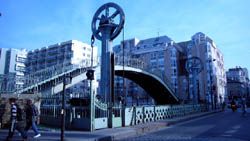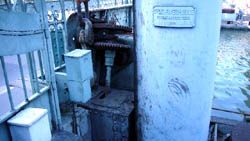 Until 1885, canal de l’Ourcq, eleven meters in width in the part that divided the two basins, was bordered by the ruins of two warehouses which burned in 1870. The former wooden swing bridge was replaced in 1871 by a metallic swing bridge. Cumbersome, it only left, once turned, 7.80 meters in width for navigation. Traffic intensity obliged it to open about twenty five times a day. Each opening interrupted land traffic for fifteen minutes for the passage of a steamer and one full hour for the passage of a larger convoy. This bottleneck passage became a real problem. It was decided to replace the swing bridge with a lift bridge that would ease land traffic, but would also be the opportunity to enlarge the navigable passage by about fifteen meters. The esthetics of the change was an important aspect. Indeed, the techniques of that era demanded imposing bearing superstructures and, more often than not, quite unesthetic. It was the project by the company "Fives Lille" who obtained the construction job.
Until 1885, canal de l’Ourcq, eleven meters in width in the part that divided the two basins, was bordered by the ruins of two warehouses which burned in 1870. The former wooden swing bridge was replaced in 1871 by a metallic swing bridge. Cumbersome, it only left, once turned, 7.80 meters in width for navigation. Traffic intensity obliged it to open about twenty five times a day. Each opening interrupted land traffic for fifteen minutes for the passage of a steamer and one full hour for the passage of a larger convoy. This bottleneck passage became a real problem. It was decided to replace the swing bridge with a lift bridge that would ease land traffic, but would also be the opportunity to enlarge the navigable passage by about fifteen meters. The esthetics of the change was an important aspect. Indeed, the techniques of that era demanded imposing bearing superstructures and, more often than not, quite unesthetic. It was the project by the company "Fives Lille" who obtained the construction job.
 A temporary bridge was constructed to allow cars to circulate and demolition of the old bridge was carried out only after the construction of the mobile part of the new one. Parallel to the construction of the bridge, canal width was enlarged from eleven to fifteen meters and the passage was deepened. But widening of the canal between the new bridge and the expansion of the basin called for the replacement of the pedestrian footbridge adjoining the main bridge. These changes required dismantling elements of the bridge which were quite apt for further use. Thus, the former footbridge was rebuilt on the Canal Saint Martin. The deck of the old bridge, recently built, was also moved to the canal Saint Martin to replace a dilapidated swing bridge at the level of Grange-aux-Belles. The lift bridge was made operational in July 1886 and weighed not less than eighty five tons. Henceforth, stopping traffic was limited to five minutes for the passage of the steamer and twenty minutes for heavier convoys. The Lift Bridge at rue Crimée is operated from the control room at the first lock on Saint Denis canal. It is possible to see the lock keeper manouver it from a distance
A temporary bridge was constructed to allow cars to circulate and demolition of the old bridge was carried out only after the construction of the mobile part of the new one. Parallel to the construction of the bridge, canal width was enlarged from eleven to fifteen meters and the passage was deepened. But widening of the canal between the new bridge and the expansion of the basin called for the replacement of the pedestrian footbridge adjoining the main bridge. These changes required dismantling elements of the bridge which were quite apt for further use. Thus, the former footbridge was rebuilt on the Canal Saint Martin. The deck of the old bridge, recently built, was also moved to the canal Saint Martin to replace a dilapidated swing bridge at the level of Grange-aux-Belles. The lift bridge was made operational in July 1886 and weighed not less than eighty five tons. Henceforth, stopping traffic was limited to five minutes for the passage of the steamer and twenty minutes for heavier convoys. The Lift Bridge at rue Crimée is operated from the control room at the first lock on Saint Denis canal. It is possible to see the lock keeper manouver it from a distance